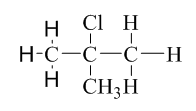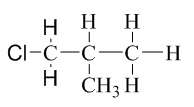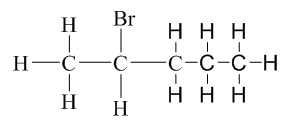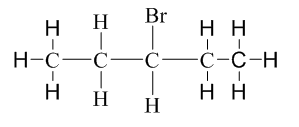
OWLV2 FOR MOORE/STANITSKI'S CHEMISTRY:
5th Edition
ISBN: 9781285460369
Author: STANITSKI
Publisher: Cengage Learning
expand_more
expand_more
format_list_bulleted
Concept explainers
Question
Chapter 7, Problem 30QRT
(a)
Interpretation Introduction
Interpretation:
Chiral centers in the given molecule have to be circled.

Concept Introduction:
Chirality: It refers to a Carbon atom in a molecule that contains four different substituents.
(b)
Interpretation Introduction
Interpretation:
Chiral centers in the given molecule have to be circled.

Concept Introduction:
Refer to (a).
(c)
Interpretation Introduction
Interpretation:
Chiral centers in the given molecule have to be circled.

Concept Introduction:
Refer to (a).
(d)
Interpretation Introduction
Interpretation:
Chiral centers in the given molecule have to be circled.

Concept Introduction:
Refer to (a).
Expert Solution & Answer
Want to see the full answer?
Check out a sample textbook solution
Students have asked these similar questions
4. Provide a clear arrow-pushing mechanism for each of the following reactions. Do not skip proton
transfers, do not combine steps, and make sure your arrows are clear enough to be interpreted
without ambiguity.
a.
2.
1. LDA
3. H3O+
HO
b.
H3C CH3
H3O+
✓ H
OH
2. Provide reagents/conditions to accomplish the following syntheses. More than one step is
required in some cases.
a.
CH3
Chapter 7 Solutions
OWLV2 FOR MOORE/STANITSKI'S CHEMISTRY:
Ch. 7.2 - Identify the electron-region geometry, the...Ch. 7.2 - Based on the discussion so far, identify a...Ch. 7.2 - Prob. 7.2PSPCh. 7.2 - Determine the electron-region geometry and the...Ch. 7.2 - Prob. 7.2CECh. 7.2 - Prob. 7.3ECh. 7.2 - Prob. 7.4PSPCh. 7.4 - Using hybridization and sigma and pi bonding,...Ch. 7.4 - Prob. 7.4CECh. 7.5 - Decide whether each molecule is polar and, if so,...
Ch. 7.5 - Prob. 7.5ECh. 7.6 - Prob. 7.8PSPCh. 7.6 - Prob. 7.7CECh. 7.6 - Prob. 7.9PSPCh. 7.7 - Prob. 7.8CECh. 7.7 - Prob. 7.9CECh. 7 - Write the Lewis structures and give the...Ch. 7 - The structural formula for the open-chain form of...Ch. 7 - Describe the VSEPR model. How is the model used to...Ch. 7 - What is the difference between the electron-region...Ch. 7 - Prob. 3QRTCh. 7 - Prob. 4QRTCh. 7 - If you have three electron regions around a...Ch. 7 - Prob. 6QRTCh. 7 - Prob. 7QRTCh. 7 - Prob. 8QRTCh. 7 - Prob. 9QRTCh. 7 - Prob. 10QRTCh. 7 - Prob. 11QRTCh. 7 - Prob. 12QRTCh. 7 - Prob. 13QRTCh. 7 - Prob. 14QRTCh. 7 - Prob. 15QRTCh. 7 - Prob. 16QRTCh. 7 - Write Lewis structures for XeOF2 and ClOF3. Use...Ch. 7 - Write Lewis structures for HCP and [IOF4]. Use...Ch. 7 - Prob. 19QRTCh. 7 - Prob. 20QRTCh. 7 - Explain why (I3)+ is bent, but (I3) is linear.Ch. 7 - Prob. 22QRTCh. 7 - Prob. 23QRTCh. 7 - Give approximate values for the indicated bond...Ch. 7 - Give approximate values for the indicated bond...Ch. 7 - Prob. 26QRTCh. 7 - Compare the FClF angles in ClF2+ and ClF2. From...Ch. 7 - Prob. 28QRTCh. 7 - Prob. 29QRTCh. 7 - Prob. 30QRTCh. 7 - Prob. 31QRTCh. 7 - Describe the geometry and hybridization of carbon...Ch. 7 - Describe the geometry and hybridization for each C...Ch. 7 - Describe the hybridization around the central atom...Ch. 7 - The hybridization of the two carbon atoms differs...Ch. 7 - The hybridization of the two nitrogen atoms...Ch. 7 - Identify the type of hybridization, approximate...Ch. 7 - Prob. 38QRTCh. 7 - Prob. 39QRTCh. 7 - Prob. 40QRTCh. 7 - Prob. 41QRTCh. 7 - Methylcyanoacrylate is the active ingredient in...Ch. 7 - Prob. 43QRTCh. 7 - Prob. 44QRTCh. 7 - Prob. 45QRTCh. 7 - Prob. 46QRTCh. 7 - Which of these molecules has a net dipole moment?...Ch. 7 - Prob. 48QRTCh. 7 - Use molecular structures and noncovalent...Ch. 7 - Prob. 50QRTCh. 7 - Explain why water “beads up” on a freshly waxed...Ch. 7 - Explain why water will not remove tar from your...Ch. 7 - Prob. 53QRTCh. 7 - Prob. 54QRTCh. 7 - Prob. 55QRTCh. 7 - Prob. 56QRTCh. 7 - The structural formula for vitamin C is Give a...Ch. 7 - Prob. 58QRTCh. 7 - Prob. 59QRTCh. 7 - Prob. 60QRTCh. 7 - Prob. 61QRTCh. 7 - Prob. 62QRTCh. 7 - Prob. 63QRTCh. 7 - Prob. 64QRTCh. 7 - Prob. 65QRTCh. 7 - Prob. 66QRTCh. 7 - Methylcyanoacrylate is the active ingredient in...Ch. 7 - Prob. 68QRTCh. 7 - Prob. 69QRTCh. 7 - Use Lewis structures and VSEPR theory to predict...Ch. 7 - In addition to CO, CO2, and C3O2, there is another...Ch. 7 - Prob. 72QRTCh. 7 - Prob. 73QRTCh. 7 - Prob. 74QRTCh. 7 - Prob. 75QRTCh. 7 - In the gas phase, positive and negative ions form...Ch. 7 - Prob. 77QRTCh. 7 - Prob. 78QRTCh. 7 - Prob. 79QRTCh. 7 - Prob. 80QRTCh. 7 - Prob. 81QRTCh. 7 - Prob. 82QRTCh. 7 - Prob. 83QRTCh. 7 - Prob. 84QRTCh. 7 - Prob. 85QRTCh. 7 - Prob. 86QRTCh. 7 - Prob. 87QRTCh. 7 - Prob. 88QRTCh. 7 - Prob. 89QRTCh. 7 - Prob. 90QRTCh. 7 - Prob. 91QRTCh. 7 - Prob. 92QRTCh. 7 - Prob. 93QRTCh. 7 - Prob. 94QRTCh. 7 - Which of these are examples of hydrogen bonding?Ch. 7 - Prob. 96QRTCh. 7 - Prob. 97QRTCh. 7 - Prob. 98QRTCh. 7 - Halothane, which had been used as an anesthetic,...Ch. 7 - Ketene, C2H2O, is a reactant for synthesizing...Ch. 7 - Gamma hydroxybutyric acid, GHB, infamous as a date...Ch. 7 - There are two compounds with the molecular formula...Ch. 7 - Piperine, the active ingredient in black pepper,...Ch. 7 - Prob. 105QRTCh. 7 - Two compounds have the molecular formula N3H3. One...Ch. 7 - Prob. 108QRTCh. 7 - Prob. 109QRTCh. 7 - Prob. 110QRTCh. 7 - Prob. 111QRTCh. 7 - Prob. 7.ACPCh. 7 - Prob. 7.BCPCh. 7 - Prob. 7.CCPCh. 7 - Prob. 7.DCP
Knowledge Booster
Learn more about
Need a deep-dive on the concept behind this application? Look no further. Learn more about this topic, chemistry and related others by exploring similar questions and additional content below.Similar questions
- Identify and provide an explanation that distinguishes a qualitative and quantitative chemical analysis. Provide examples.arrow_forwardIdentify and provide an explanation of the operational principles behind a Atomic Absorption Spectrometer (AAS). List the steps involved.arrow_forwardInstructions: Complete the questions in the space provided. Show all your work 1. You are trying to determine the rate law expression for a reaction that you are completing at 25°C. You measure the initial reaction rate and the starting concentrations of the reactions for 4 trials. BrO³¯ (aq) + 5Br¯ (aq) + 6H* (aq) → 3Br₂ (l) + 3H2O (l) Initial rate Trial [BrO3] [H*] [Br] (mol/L) (mol/L) | (mol/L) (mol/L.s) 1 0.10 0.10 0.10 8.0 2 0.20 0.10 0.10 16 3 0.10 0.20 0.10 16 4 0.10 0.10 0.20 32 a. Based on the above data what is the rate law expression? b. Solve for the value of k (make sure to include proper units) 2. The proposed reaction mechanism is as follows: i. ii. BrО¸¯ (aq) + H+ (aq) → HBrO3 (aq) HBrO³ (aq) + H* (aq) → H₂BrO3* (aq) iii. H₂BrO³* (aq) + Br¯ (aq) → Br₂O₂ (aq) + H2O (l) [Fast] [Medium] [Slow] iv. Br₂O₂ (aq) + 4H*(aq) + 4Br(aq) → 3Br₂ (l) + H2O (l) [Fast] Evaluate the validity of this proposed reaction. Justify your answer.arrow_forward
- a. H3C CH3 H, 1.0 equiv. Br2arrow_forwardH3C. H3C CH 3 CH 3 CH3 1. LDA 2. PhSeCl 3. H2O2arrow_forwardPlease predict the products for each of the following reactions: 1.03 2. H₂O NaNH, 1. n-BuLi 2. Mel A H₂ 10 9 0 H2SO4, H₂O HgSO4 Pd or Pt (catalyst) B 9 2 n-BuLi ♡ D2 (deuterium) Lindlar's Catalyst 1. NaNH2 2. EtBr Na, ND3 (deuterium) 2. H₂O2, NaOH 1. (Sia)2BH с Darrow_forward
- in the scope of ontario SCH4U grade 12 course, please show ALL workarrow_forwardIs the chemical reaction CuCl42-(green) + 4H2O <==> Cu(H2O)42+(blue) + 4Cl- exothermic or endothermic?arrow_forwardIf we react tetraethoxypropane with hydrazine, what is the product obtained (explain its formula). State the reason why the corresponding dialdehyde is not used.arrow_forward
arrow_back_ios
SEE MORE QUESTIONS
arrow_forward_ios
Recommended textbooks for you
 Chemistry: The Molecular ScienceChemistryISBN:9781285199047Author:John W. Moore, Conrad L. StanitskiPublisher:Cengage Learning
Chemistry: The Molecular ScienceChemistryISBN:9781285199047Author:John W. Moore, Conrad L. StanitskiPublisher:Cengage Learning Chemistry for Engineering StudentsChemistryISBN:9781337398909Author:Lawrence S. Brown, Tom HolmePublisher:Cengage Learning
Chemistry for Engineering StudentsChemistryISBN:9781337398909Author:Lawrence S. Brown, Tom HolmePublisher:Cengage Learning Introductory Chemistry: An Active Learning Approa...ChemistryISBN:9781305079250Author:Mark S. Cracolice, Ed PetersPublisher:Cengage Learning
Introductory Chemistry: An Active Learning Approa...ChemistryISBN:9781305079250Author:Mark S. Cracolice, Ed PetersPublisher:Cengage Learning Chemistry & Chemical ReactivityChemistryISBN:9781337399074Author:John C. Kotz, Paul M. Treichel, John Townsend, David TreichelPublisher:Cengage Learning
Chemistry & Chemical ReactivityChemistryISBN:9781337399074Author:John C. Kotz, Paul M. Treichel, John Townsend, David TreichelPublisher:Cengage Learning Chemistry & Chemical ReactivityChemistryISBN:9781133949640Author:John C. Kotz, Paul M. Treichel, John Townsend, David TreichelPublisher:Cengage Learning
Chemistry & Chemical ReactivityChemistryISBN:9781133949640Author:John C. Kotz, Paul M. Treichel, John Townsend, David TreichelPublisher:Cengage Learning Chemistry: Principles and PracticeChemistryISBN:9780534420123Author:Daniel L. Reger, Scott R. Goode, David W. Ball, Edward MercerPublisher:Cengage Learning
Chemistry: Principles and PracticeChemistryISBN:9780534420123Author:Daniel L. Reger, Scott R. Goode, David W. Ball, Edward MercerPublisher:Cengage Learning

Chemistry: The Molecular Science
Chemistry
ISBN:9781285199047
Author:John W. Moore, Conrad L. Stanitski
Publisher:Cengage Learning

Chemistry for Engineering Students
Chemistry
ISBN:9781337398909
Author:Lawrence S. Brown, Tom Holme
Publisher:Cengage Learning

Introductory Chemistry: An Active Learning Approa...
Chemistry
ISBN:9781305079250
Author:Mark S. Cracolice, Ed Peters
Publisher:Cengage Learning

Chemistry & Chemical Reactivity
Chemistry
ISBN:9781337399074
Author:John C. Kotz, Paul M. Treichel, John Townsend, David Treichel
Publisher:Cengage Learning

Chemistry & Chemical Reactivity
Chemistry
ISBN:9781133949640
Author:John C. Kotz, Paul M. Treichel, John Townsend, David Treichel
Publisher:Cengage Learning

Chemistry: Principles and Practice
Chemistry
ISBN:9780534420123
Author:Daniel L. Reger, Scott R. Goode, David W. Ball, Edward Mercer
Publisher:Cengage Learning